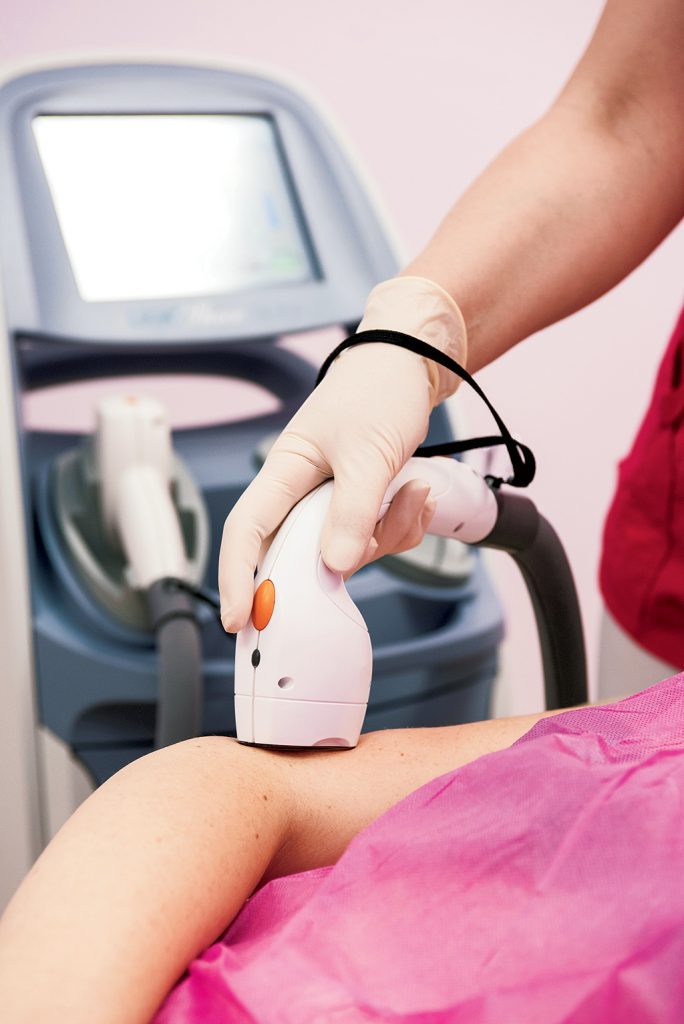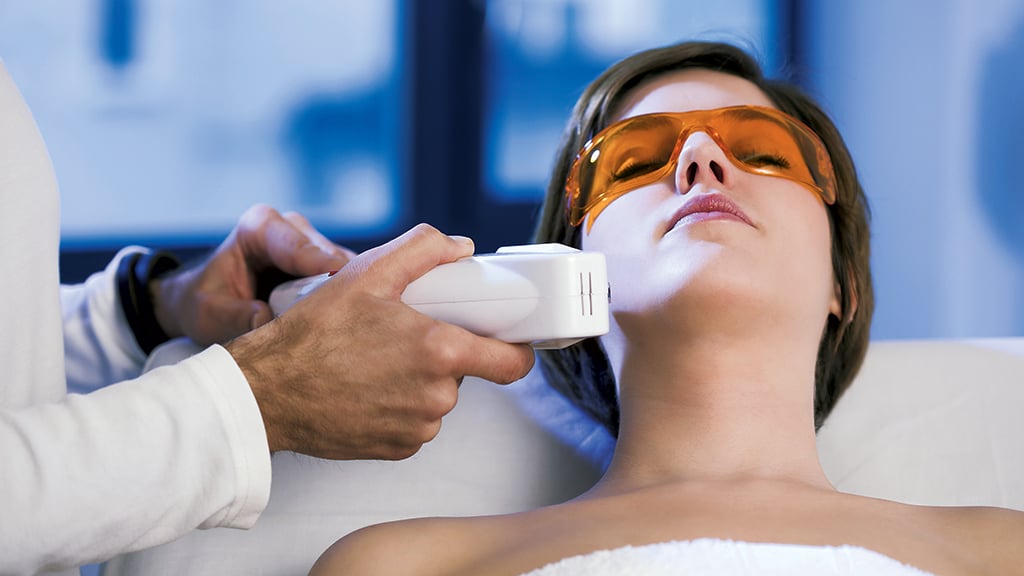Shaving, waxing, tweezing, sugaring. There are almost as many well-worn ways to remove body and facial hair as there are areas that it sprouts on.
And then there are lasers. The American Society of Plastic Surgeons estimates that more than a million Americans used the procedure in 2014, a 51-percent rise since 2000.
Once forbiddingly high-tech, laser hair removal has been democratized. Laser prices are down, availability in medical offices and salons is ubiquitous, and there’s no shortage of pop culture devoted to the devices: Witness Kim and Khloe Kardashian getting laser hair removal on an episode of Keeping Up With the Kardashians.
“When I started working with lasers 17 years ago, the procedure wasn’t as common and it was more expensive,” says Sue Lee, owner of Capital Laser in Rosslyn. “Plus, now the process is much less painful, since the laser pulses are quicker and there’s new cooling technology.”
Still, this method of hair removal isn’t exactly cheap yet—the average price for treating one area of the body is about $1,700. And if you envision some sort of quick, Star Wars–style ray-gun blast, it’s not that simple: You’ll have to treat most areas multiple times over months for a significant reduction in hair growth.
So how do you choose where—or if—to go under the light?
How It Works
Unlike shaving and waxing, which remove hair already on the skin’s surface, lasers target what lies beneath: the follicle under your dermis. Using selective photothermolysis (SPTL), lasers cause localized damage by heating dark targets (in this case, melanin in the follicles) without burning the rest of the skin.
With a hand piece that looks like a vacuum cleaner’s hose attachment, a technician or physician emits split-second beams of light to preshaved skin. The energy destroys the hair bulb underneath, and a few days or weeks later, the remaining hairs push out, shedding what looks like a bunch of eyelashes, ashes, or, occasionally, a small clump of hair.
How Long It Takes
Sessions vary in length depending on which body part you’re having treated—a little fuzz on your chin might take five minutes to zap, while a thick-skinned man’s back could require 30 minutes or more. No matter where you’re going barer, you’ll likely need six to eight sessions with a professional-level laser to see full results, typically an 80-to-90-percent reduction in hair growth.
The reason for so many visits? Laser beams work best on follicles in the active “anagen” growth phase, and to kill all (or nearly all) in one zone, you have to come back several times.
Humans have anywhere from 50 to more than 300 follicles per square inch of skin. “It’s unpredictable how many you’ll catch in an active state,” says Shobha Tummala, founder of Shobha, a hair-removal chain known for sugaring and waxing that recently started offering laser hair removal at its downtown DC branch. “All kinds of things can affect how many hairs will be hit in a given session—hormones, vitamins.”
Other times, patients are surprised by how quickly they become smoother. “I was shocked that even after only four visits to the laser clinic, I went from having a thick, bushy bikini line to nearly nothing,” says a woman we’ll call Andrea for privacy reasons. “I didn’t even finish up my series, and I’m still happy with the results.”
Patients often choose to undergo the procedure during what the industry calls “laser season”—fall through spring, when letting hair regrow between sessions isn’t as noticeable. That’s because, while you’re allowed to shave between appointments, you can’t wax or tweeze. “The follicles need to be present so you can get at them,” says Lee. “You can’t laser something that isn’t there.”
RELATED: 6 Quick, New Skin-Saving Products to Try
Picking the Right Laser
The type of lasers used to zap follicles varies depending on your skin and your natural hair color. Diode and alexandrite lasers, which emit shorter pulses, are usually good for fair and medium complexions with darker, coarser hair. Olive-to-black-skinned customers are typically treated with the Nd:YAG laser, which has a longer wavelength, meaning beams penetrate deeper into the skin so as not to burn the surface; laser burns were once more of an issue for darker complexions with more melanin. Still, technicians sometimes do use less power to avoid burning darker-skinned clients.
Blonds and redheads can be treated, but the lower level of melanin in their hair means lasers won’t be as effective, and some practices won’t even take on those patients. Gray hair can’t be targeted by lasers due to its lack of melanin, so beware a practice that says it can.
“When someone with fair hair requests laser removal, I steer them towards an alternative treatment such as threading or waxing,” says dermatologist Tina Alster, founding director of the Washington Institute of Dermatologic Laser Surgery, which has offices in downtown DC and Chevy Chase. Dr. Alster’s practice has been using lasers to banish hair since the early ’90s.
Seek out an experienced practitioner, whether that’s a laser technician with board certification in his or her jurisdiction or, to be extra-cautious, a dermatologist, who can better address potential complications such as burns, scarring, or blistering.
If you opt for a laser hair-removal center, look for a practice devoted to that, not hair or nail salons that do it on the side and thus may not have the best lasers or most experienced staff. And look for membership in professional organizations such as the Society for Clinical & Medical Hair Removal and the International Aesthetic & Laser Association.
Where You Can You Get Zapped
Like that trusty Gillette or pot of wax, lasers work on almost any area where hair grows. It’s a particular boon in zones of coarse growth—the bikini line, men’s necks—that are prone to bumps and irritation from shaving.
“We’ve got lots of male clients who like to lighten their facial-hair loads, particularly if they are susceptible to folliculitis”—inflamed or infected hairs—says Alster.
The most common zone to treat? For men, backs and chests; for women, bikini lines and underarms. “I’m quite fair, but it’s weird—my underarm hair was really dark, like a 5 o’clock shadow,” says Heather Klein of Potomac, who had her armpits and bikini line lasered in 2011 and 2012. “The treatment really worked, and now I can wear a sleeveless top.”
Legs, arms, and stomach are also top choices, as are small areas of the face—cheeks, chins, and unibrows. “But you can’t do the under part of your eyebrows,” says Shobha Tummala. “The laser could burn your eye.” That’s also why technicians and anyone getting zapped must wear protective goggles during treatment.

The Long-Term Results
The Food and Drug Administration considers laser hair removal a “hair reduction” treatment because, at any time, previously inactive follicles can begin producing new hairs due to hormonal changes and other factors.
As for active follicles, the more treatments you get, the sparser the regrowth and the weaker the remaining hairs. “Follicles are a lot like weeds,” says Alster. “The more you attack them with a laser, the fewer come back the next time.”
Dr. Eliot Battle, cofounder of Cultura medical spa in Friendship Heights, says that as treatment progresses and hair gets finer and thinner, he might use a different type of laser.
Many patients report that even if they still have a few remaining hairs in the area treated, the thinner, scarcer growth is simple to manage with a razor or occasional wax job. Others go back for a laser session once a year to pick off strays.
Home Remedies
The same technological advances that have propelled the in-office laser boom have produced a slew of new at-home devices.
“They can be a great deal—usually $500 to $800 apiece,” says Alster. “They’re not as strong as in-office machines, so you have to do twice as many treatments as you would at a doctor’s office. But people like the idea of lasering in the privacy of their home.”
Top brands include Tria, which uses diode lasers that emit zaps at single wavelengths, similar to salon models. Also available: cheaper intense pulsed light (IPL) hair-reduction devices, such as the ones made by Veet, which put out beams of light at multiple wavelengths, meaning less targeted zaps and slower defuzzing.
RELATED: 3 Recommended At-Home Waxing Options
The Cost
In 2014, the American Society of Plastic Surgeons estimated that the average laser hair-reduction session cost $289 (which, assuming a six-session round of treatments, adds up to $1,734). But in the Washington area, fees vary widely. Most customers buy a three- or six-time package deal, which yields a slight discount over single sessions. (At Shobha, three-session bikini-line banishing runs $396, a $45 savings over buying individual appointments.) Going to a dermatologist typically costs more than visiting a salon.
“It was expensive to do my bikini line—about $1,500 total,” says a woman we’ll call Alice. “But every time they hit me with those beams, I’d think about how much I’d spent on waxing for the past ten years, and I’d feel like it was worth it.”
Beware Groupon-like deals that seem too good to be true. They often come from inexperienced practitioners or from businesses, such as a nail salon, using cheaper, less effective lasers.
The Pain Factor
How much does laser hair removal hurt? The answer depends on your pain threshold, your hair’s color and texture, and the area treated.
“The rule of thumb is that if your hair is darker and coarser, it’s more painful to get rid of,” says Sue Lee of Capital Laser. “The laser has to expend more energy to target it.” Most people describe the zaps as feeling like pinpricks or a rubber-band snap. The ouch factor increases on delicate areas (the Brazilian zone of the bikini line for those taking it all off) and in regions where hair is denser.
“Having my back lasered wasn’t what I’d call an enjoyable experience,” says a man we’ll call Fred. “It felt a little like a series of stinging bug bites, and the duration was worse than the zaps.” Others report only mild irritation. “Getting lasered was somewhat like being pinched,” says Klein. “I felt it more on my bikini line, but it really wasn’t a big deal.”
Technicians can apply numbing cream before treatment to ease the pain—just don’t apply it yourself prior to an appointment, because it’s possible to have an adverse reaction if you overdo the stuff. Post-treatment ice packs and over-the-counter cortisone cream also help with residual redness and bumps, most of which disappear within 24 hours.
Plus, technology is on your side. Modern lasers are equipped with cooling elements to offset overheating skin—specifically, blasts of cold air before or after laser pulses.“And in the past few years, the lasers have gotten much quicker—we’re talking zaps that last a fraction of a second,” says Fadia Hoyek, executive vice president at the Society of Clinical & Medical Hair Removal, a nonprofit devoted to hair-removal education. “Your brain doesn’t have much time to process what’s happening.”
Safety Concerns
Before committing to this type of hair removal, go for a consultation to be sure you’re a good candidate and you feel confident in the practitioner. A good one should issue pre-laser precautions. An important caveat: Don’t go for a laser treatment if you’re tanned or sunburned or have used a tanning product in the past four to eight weeks. Lasers function by picking up the difference between skin color and hair color, and darker skin could result in extra energy, leading to redness, burns, or blisters. In rare cases, a burn or scar could cause either hypopigmentation (paler spots) or hyperpigmentation (dark spots).
Serious side effects, however, are uncommon. “There is no evidence that there are any negative long-term adverse effects from laser hair reduction,” says Alster. “We use non-ionizing irradiation, so these lasers are safer than exposing your skin to the sun.”
In a 2000–02 study in the Aesthetic Surgery Journal, a test group of 322 subjects received laser hair treatments with a long-pulse alexandrite laser, and just ten reported complications (hypo- and hyperpigmentation).
“Laser hair removal has been around for a long time,” says Michael Olding, head of the GW Medical Faculty Associates’ Cosmetic Surgery Center. “If there were serious complications, we would know by now.”
Want to try something else? Check out dermaplaning, an easy way to remove stubborn peach fuzz:
Jennifer Barger (jnbarger@gmail.com) is a freelance style writer and personal shopper.
This article appears in our February 2016 issue of Washingtonian.













